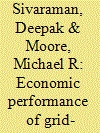|
|
|
Sort Order |
|
|
|
Items / Page
|
|
|
|
|
|
|
| Srl | Item |
| 1 |
ID:
115654


|
|
|
|
|
| Publication |
2012.
|
| Summary/Abstract |
Various public policies in the United States are providing financial incentives for installation and generation of electricity from renewable resources. This article examines the influence of investment subsidies, greenhouse gas (GHG) prices, and renewable energy credit (REC) prices on the economic performance of grid-connected photovoltaic (PV) systems. Our model integrates PV output, capacity-factor-based dispatch, and cost-benefit financial components to evaluate new PV installations in California and Texas. Relative to the base case, the benefit-cost ratio increases between 5-53% in California and 5-38% in Texas for the policy-derived cases of GHG and REC prices. The economic performance of PV is higher in California due to higher grid electricity prices and the profile of displaced marginal fuels. A sensitivity analysis demonstrates the electricity and GHG prices required to achieve profitability. A key element of the economic analysis demonstrates the importance of assessing the marginal fuels displaced by the PV system, not the average mix of displaced fuels, in terms of accurately monetizing the GHG abatement embodied in the displaced fuels. In California, for example, the discounted benefits derived from pollution abatement under the marginal displacement approach were 1.6-3.0 times higher than under the three average fuel mix cases.
|
|
|
|
|
|
|
|
|
|
|
|
|
|
|
|
| 2 |
ID:
103371


|
|
|
|
|
| Publication |
2011.
|
| Summary/Abstract |
The Clean Development Mechanism (CDM) of the Kyoto Protocol represents an opportunity to involve all developing countries in the effort to reduce greenhouse gas emissions while also promoting sustainable development. To date, however, the majority of CDM projects have gone to emerging markets such as China, India, Brazil, and Mexico, while very few least developed countries have hosted projects. This paper investigates the differential distribution of CDM activities across countries. We develop a conceptual model for project profitability, which helps to identify potential country-level determinants of CDM activity. These potential determinants are employed as explanatory variables in regression analysis to explain the actual distribution of projects. Human capital and greenhouse gas emission levels influenced which countries have hosted projects and the amount of certified emission reductions (CER) created. Countries that offered growing markets for CDM co-products, such as electricity, were more likely to be CDM hosts, while economies with higher carbon intensity levels had greater CER production. These findings work against the least developed countries and help to explain their lack of CDM activity.
|
|
|
|
|
|
|
|
|
|
|
|
|
|
|
|
| 3 |
ID:
098646


|
|
|
|
|
| Publication |
2010.
|
| Summary/Abstract |
Green electricity generation can provide an indirect route to cleaner air: by displacing generation from fossil fuels, green electricity can reduce emissions of CO2 and conventional air pollutants. Several types of voluntary markets have emerged in the United States to take advantage of this relationship, including green electricity programs, carbon offsets, and renewable energy certificates. At the same time, regulators are favoring cap-and-trade mechanisms for regulating emissions. This paper describes the appropriate framing of environmental claims for green electricity products. We apply an accounting framework for evaluating claims made for capped pollutants, with entries for emissions, avoided emissions due to green electricity, and unused emission permits. This framework is applied in case studies of two major electric utilities that operate with green electricity programs and capped pollutants. The cases demonstrate that the relative magnitude of "unused permits" and "emissions avoided" is a key relationship for evaluating an emissions reduction claim. Lastly, we consider the evolution of the green electricity marketplace given the reliance on cap-and-trade. In this setting, pollution-emission products could be decoupled from one another and from the various green electricity products. Several positive consequences could transpire, including better transparency of products, lower certification costs, and more product choices.
|
|
|
|
|
|
|
|
|
|
|
|
|
|
|
|
|
|
|
|
|